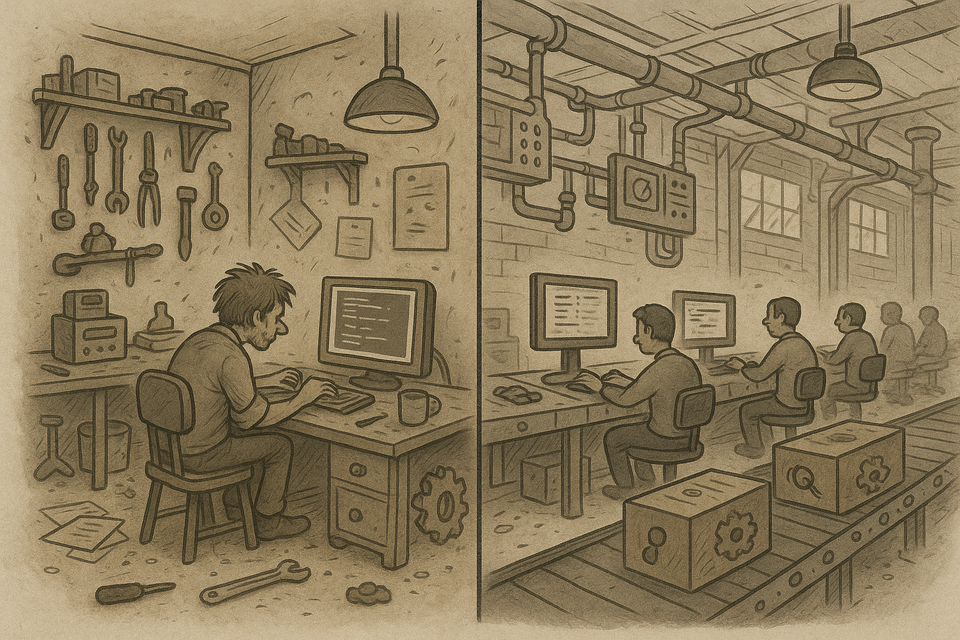Platform Leverage: A Systems Thinking Case for Strategic Investment

This article outlines how strategic investment in platform teams can reduce time-to-market, improve profitability, and increase delivery capacity, not through scaling effort, but through deliberate system design. Drawing from systems thinking and industrial principles, it explains how platform teams act on structural leverage points to transform software delivery from reactive execution into efficient, repeatable flow.
Introduction
In most organisations, improving delivery means increasing inflow: hiring more engineers, launching more features, accelerating timelines. However, as Donella Meadows reminds us in Thinking in Systems, the health of a system can be improved not only by increasing what flows in, but also by reducing what leaks out.
This is where platform strategy becomes essential. When executed with intent, platform teams do not simply accelerate delivery. They shape the system to make delivery more cost-effective, faster, and more sustainable. In doing so, their efficacy mirrors the efficiency of customer-facing teams, as both are dependent on the health and design of the overall system.
Platform as a Profit Lever
Platform work reduces the cost of change, cost per feature, and time to market over time:
- Shared abstractions reduce cognitive overhead and duplication.
- Self-service primitives accelerate onboarding and implementation.
- Guardrails and automation decrease incidents and rework.
- Observability and data access shorten feedback loops.
Rather than relying solely on labour (more teams, more individuals), platforms act upon the structure of delivery, changing the shape of the system to enable compound efficiency gains.
In effect, this approach mirrors the industrial principles of Fordism and Taylorism: it transforms software delivery into a structured production system. In the early 20th century, Ford revolutionised manufacturing by introducing standardised parts, repeatable workflows, and assembly lines. These innovations drastically reduced the cost and time required to produce each vehicle without compromising on quality.
Similarly, platform teams enable software organisations to move away from artisanal, one-off implementations toward systematised, repeatable delivery. By investing in shared pipelines, common tooling, interface standards, and automation, platform work increases delivery velocity and consistency without increasing coordination overhead.
This is not about rigid control but about building an environment where scale does not mean chaos, and where each team benefits from an industrial-strength foundation. Just as Ford's innovations enabled consistency without slowing the line, platform investment allows engineering teams to deliver with autonomy and quality. At speed and scale. This is how software delivery becomes a high-leverage discipline rather than a labour-intensive grind.
Why Teams Are Not Agencies
Treating teams as execution agencies, responding to external orders, bloats the organisation:
- Feedback loops become longer.
- Teams lose local autonomy and context.
- Coordination costs increase.
- Teams optimise for output, not for impact.
This reduces the organisation’s ability to adapt and results in delivery patterns rooted in local effort rather than systemic leverage. Worse still, it erodes motivation and ownership, creating the seeds for attrition as engineers lose the sense of purpose and agency. Architecturally, it invites chaos, as local teams implement ad-hoc solutions disconnected from platform strategy. Process-wise, it breeds complexity and confusion, as fragmented decisions accumulate without coherent oversight.
In effect, this model becomes a recipe for systemic dysfunction, one that scales fragility, not performance.
System Thinking: Acting on Leverage Points
Meadows outlines several ways to intervene in a system. The table below demonstrates how platform teams align:
| System Element | Execution Agency (Anti-Pattern) | Platform Leverage (Healthy System) |
|---|---|---|
| Flows | Teams absorb demand without filtering | Platforms reduce outflow through shared services |
| Stocks | Delivery capacity treated as a fixed asset | Platforms increase sustainable delivery capacity over time |
| Feedback Loops | Delayed, indirect, often ignored | Real-time telemetry, safety mechanisms, faster learning cycles |
| Information Structures | Centralised decisions, fragmented context | Distributed, discoverable context and tooling |
| System Rules | Teams follow externally imposed logic | Platforms encode improved rules via interfaces and defaults |
| Leverage Points | Ignored or misunderstood | Platform work operates at structural levels (rules, flows) |
Analogy: Thermostat versus Heater
Execution teams are akin to heaters: they apply energy to produce output. Platform teams, when trusted, become thermostats: regulating the environment, enabling safety, adapting to conditions, and optimising the system as a whole.
When platform teams are forced to act like additional heaters, the organisation loses its ability to regulate and improve its own delivery environment. This dynamic leads to systemic overheating: more and more energy is expended, yet less meaningful work is accomplished. As entropy increases, coordination breaks down, quality deteriorates, and the system begins to consume itself, producing heat without progress.
Imagine a car running at full revs while the brakes are engaged. The engine generates intense heat, but the vehicle barely moves. Over time, brake pads wear out, friction escalates, and the few moments of motion come at an unsustainable cost. In such a system, energy is no longer converted into forward movement : it is dissipated as waste. It is a clear signal that the system has lost coherence and is heading toward structural failure.
The Case for Outflow Reduction
Outflow is often invisible, but insidiously expensive:
- Onboarding delays
- Fragmented developer experiences
- Incident recovery and debugging
- Redundant infrastructure and tooling
Platform teams are uniquely positioned to seal these leaks. In doing so, they prevent the constant drainage of system energy and effort, and thereby, increase the organisational stock: more retained knowledge, more usable time, and more delivery capacity. This not only improves productivity . It directly supports profitability.
Final Thought
"If you want to influence the behaviour of a system, do not push on the outputs. Change the structure." — Donella Meadows
Platform teams are not a cost centre. They represent the organisation’s highest leverage investment, provided they are empowered to operate on the system, not merely within it.
Leverage surpasses labour. Every time.
By designing systems that retain energy, amplify impact, and minimise friction, platform work becomes the silent engine behind all high-performing organisations. It is not just a support function. It is structural advantage, encoded.





Member discussion